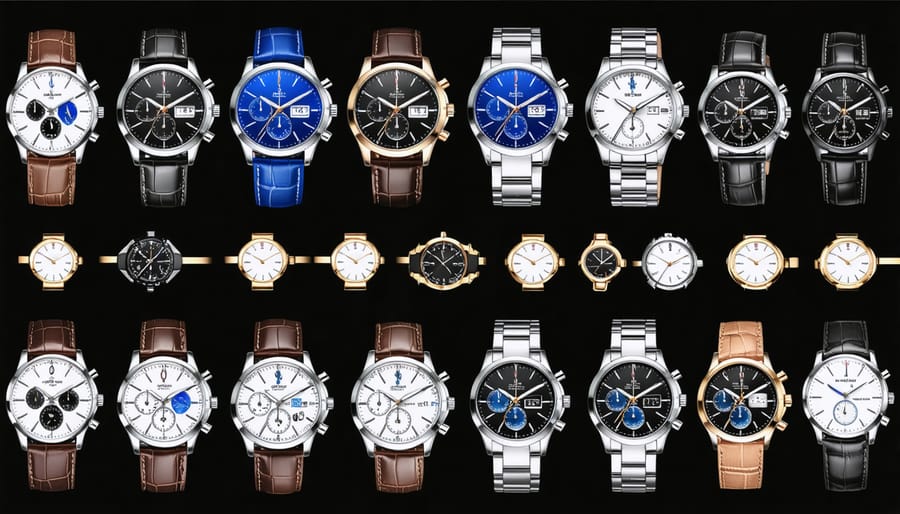In the intricate world of timekeeping, quartz stands as a revolutionary force that transformed the watch industry in the 1970s. This crystalline mineral, when precisely cut and electrified, vibrates exactly 32,768 times per second, creating the most accurate and reliable timekeeping mechanism available to the mass market. While mechanical watches celebrate centuries of craftsmanship, quartz movements deliver unmatched precision, losing just a few seconds per month compared to their mechanical counterparts that may drift minutes within days. The technology’s combination of accuracy, affordability, and minimal maintenance requirements has made it the backbone of modern watchmaking, powering everything from affordable timepieces to luxury chronographs. Understanding why quartz dominates the watch industry reveals a perfect marriage of natural material properties and innovative engineering that continues to shape how we track time in the modern era.
The Science Behind Quartz Timekeeping

The Piezoelectric Effect
At the heart of modern timekeeping lies a fascinating phenomenon known as the piezoelectric effect. This unique property is one of the most remarkable physical properties of quartz, allowing it to convert mechanical pressure into electrical energy and vice versa. When an electric current is applied to a quartz crystal, it vibrates at an incredibly precise frequency of 32,768 times per second.
This consistent oscillation serves as the foundation for accurate timekeeping in quartz watches. The crystal’s vibrations are measured by the watch’s integrated circuit, which converts these regular pulses into one-second intervals. The precision of these vibrations is remarkably stable, varying by only a few seconds per month under normal conditions.
What makes this mechanism so reliable is that quartz crystals maintain their vibrational frequency regardless of temperature changes or mechanical stress, ensuring consistent timekeeping performance. This natural property, combined with simple electronic circuits, creates an accurate and dependable timekeeping system that has revolutionized the watch industry.
From Crystal to Clock
The journey from crystal vibration to timekeeping begins when an electric current is applied to the quartz crystal, causing it to vibrate at a precise frequency of 32,768 times per second. This phenomenon, known as the piezoelectric effect, creates consistent and reliable oscillations that serve as the watch’s heartbeat.
These vibrations are then sent to an integrated circuit, which contains a tiny microchip that counts the oscillations and converts them into one-second intervals. The circuit acts like a digital counter, dividing the crystal’s rapid vibrations into manageable units of time. Once processed, these electrical pulses drive the watch’s motor, which moves the hands on analog watches or updates the display on digital ones.
The entire system operates with remarkable precision, typically losing or gaining only a few seconds per month. This level of accuracy is achieved through a sophisticated feedback loop that continuously monitors and adjusts the crystal’s vibrations to compensate for environmental factors like temperature changes and mechanical stress, ensuring reliable timekeeping in various conditions.
Unmatched Accuracy and Reliability
Precision by the Numbers
When it comes to timekeeping accuracy, quartz watches demonstrate remarkable precision that mechanical watches struggle to match. A typical quartz watch deviates by only 15-25 seconds per month, translating to an accuracy rate of 99.998%. In contrast, even the finest mechanical watches typically deviate by 5-10 seconds per day.
To put this in perspective, a standard quartz watch loses roughly one second every two days, while a high-end mechanical timepiece might lose that same second within just a few hours. Premium thermocompensated quartz movements can achieve even greater accuracy, with some models deviating by only 5-10 seconds per year.
This precision is particularly evident in chronometer certification standards. While mechanical chronometers must maintain accuracy within -4/+6 seconds per day to achieve certification, quartz chronometers easily surpass this benchmark, typically maintaining accuracy within ±0.07 seconds per day. These statistics explain why quartz movements dominate the watch market, accounting for approximately 90% of all watches produced globally.

Long-Term Performance
Quartz watches have earned a stellar reputation for their long-term durability and minimal maintenance requirements. Unlike mechanical watches that need regular servicing every 3-5 years, quartz movements can operate reliably for decades with only basic battery replacements needed every 2-3 years. The solid-state electronics in quartz watches have no moving parts that wear down over time, eliminating the need for lubrication or adjustment of complex mechanical components.
Most quartz watches maintain their accuracy throughout their lifetime, typically losing or gaining only a few seconds per month. This consistent performance doesn’t deteriorate significantly with age, making them exceptionally reliable timepieces. The simple construction also means fewer potential points of failure, resulting in lower repair costs and less frequent maintenance visits to watchmakers.
Modern quartz movements often include features like low battery indicators and power-saving modes, further enhancing their practical longevity. With proper care and regular battery changes, a quality quartz watch can easily serve as a dependable timekeeper for generations.
Cost-Effectiveness and Accessibility
One of the most compelling reasons for quartz’s dominance in watchmaking is its exceptional cost-effectiveness. Quartz movements require fewer parts than mechanical alternatives and can be mass-produced efficiently, significantly reducing manufacturing costs. This economic advantage translates directly to consumers, who can purchase reliable timepieces at much lower price points compared to mechanical watches.
The manufacturing process for quartz movements is highly automated, requiring minimal human intervention. While a mechanical watch might contain over 100 precisely engineered parts that need careful assembly, a quartz movement typically uses around 50-100 components that can be assembled by machines. This streamlined production not only reduces costs but also ensures consistent quality across large production runs.
Accessibility extends beyond just price point. Quartz watches require minimal maintenance compared to their mechanical counterparts. While mechanical watches typically need servicing every 3-5 years, a quartz watch mainly needs battery replacement every 2-3 years, a simple and inexpensive procedure that can often be done at home or at any local watch shop.
The durability of quartz movements also contributes to their cost-effectiveness. These watches can withstand more shock and varying environmental conditions without losing accuracy, resulting in longer lifespans and fewer repair needs. This reliability makes quartz watches particularly appealing for everyday use, especially in professional environments where accurate timekeeping is essential but budget constraints exist.
The combination of low production costs, minimal maintenance requirements, and long-term durability has made quartz watches accessible to a global market, democratizing accurate timekeeping for millions of consumers worldwide.

Design Versatility
Quartz movements have revolutionized watch design by offering unprecedented flexibility and creative freedom to watchmakers. Their compact size and simplified construction allow designers to experiment with various case shapes, sizes, and complications without the spatial constraints typically associated with mechanical movements.
The slim profile of quartz mechanisms enables the creation of ultra-thin watches that would be challenging to achieve with traditional mechanical movements. This characteristic has been particularly valuable in the development of elegant dress watches and fashionable timepieces that prioritize sleek aesthetics.
The reliability and precision of quartz movements also support the integration of additional functions without compromising accuracy. Features like chronographs, multiple time zones, perpetual calendars, and digital displays can be easily incorporated into quartz watches. This versatility has led to the development of multi-functional sports watches, tactical timepieces, and sophisticated dress watches that combine form with function.
Beyond practical applications, quartz movements have democratized watch design by reducing production costs. This cost-effectiveness allows manufacturers to invest more resources in exterior design elements, such as case materials, dial treatments, and finishing techniques. As a result, consumers can access watches with premium aesthetics at more accessible price points.
The consistency of quartz movements also enables manufacturers to maintain quality across different design variations, making it possible to create diverse collections that cater to various style preferences while ensuring reliable timekeeping performance. Whether it’s a minimalist dress watch or a complex sports chronograph, quartz technology provides the foundation for versatile design expression in modern watchmaking.
Environmental Considerations
Quartz watches stand out for their impressive energy efficiency, making them an environmentally conscious choice in timepiece technology. A single small battery can power a quartz watch for several years, significantly reducing the need for frequent battery replacements and their associated environmental impact. Most modern quartz watches operate on a battery that lasts between 2-5 years, with some advanced models extending battery life up to 10 years through innovative power-saving features.
The minimal energy requirements of quartz movements contribute to their sustainability profile. The crystal oscillates at a consistent frequency while consuming mere microwatts of power, making it one of the most energy-efficient timekeeping mechanisms available. Manufacturers have further enhanced this efficiency by incorporating solar charging capabilities and kinetic energy harvesting systems in newer models, reducing battery waste and extending operational lifespans.
Additionally, the durability of quartz movements means fewer replacements are needed over time, contributing to reduced electronic waste in the long term.
Quartz watches have revolutionized timekeeping by offering an unbeatable combination of accuracy, affordability, and reliability. Their minimal maintenance requirements, coupled with exceptional precision, make them a practical choice for everyday wear. The durability of quartz movements ensures these timepieces can withstand daily use while maintaining their performance. While mechanical watches hold their own appeal for collectors and luxury enthusiasts, quartz technology continues to dominate the watch industry due to its cost-effectiveness and dependability. Whether in basic models or high-end designer pieces, quartz movements provide the consistent, precise timekeeping that modern lifestyles demand, making them an enduring choice for both casual consumers and discerning watch enthusiasts.










